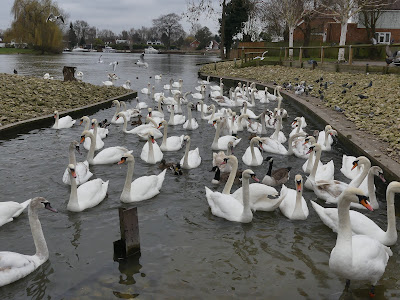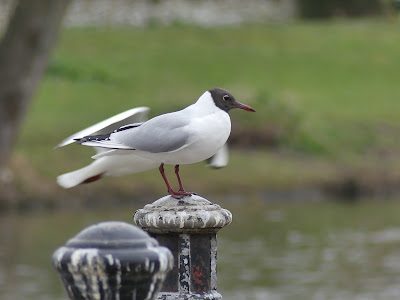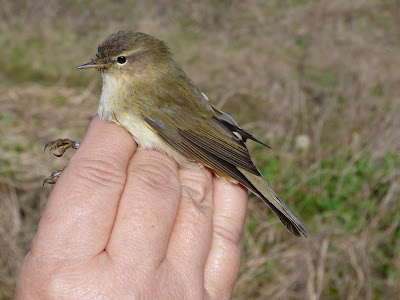Wednesday 14th depart for Tendaba
We travelled via Farasutu as the Greyish Eagle Owl had been relocated. We had sightings of Four-banded Sandgrouse, Bruce's Green Pigeon and Black-winged Kite before reaching the tree where the owls had chosen to roost.
Greyish Eagle Owl
Black-winged Kite
As a bonus, a Standard-winged Nightjar had been found by the local rangers, so we next set off in the direction of that bird. On the way a Black-crowned Tchagra was seen
Black-crowned Tchagra
On arriving at the site, we were told that the Nightjar had been flushed earlier. Being ever positive, we all began searching the leaf litter
beneath the sparsely leaved bushes. A short while later a female was located a
short distance from the male’s usual roosting spot.
Standard-winged Nightjar female
We continued our journey taking a lunch stop by the road where birds of prey are often seen.
Rufus-crowned Roller
We drove on to Tendaba, where we looked around the camp, until it was time for a boat trip through the creeks in the late afternoon. We had close views of many of the specialities including African Finfoot and Goliath Heron.
Crossing the Gambia River
White-throated Bee-eater
African Finfoot
Pink-backed Pelican
Blue-breasted Kingfisher
There was a large pod of Bottle-nosed Dolphins moving down river as
we neared the jetty at the end of our boat trip.

The sun was close to setting and with a lot of dust in the air there was an unusual diffuse quality to the light. We were looking forward to another boat trip the next morning and made arrangements for an early breakfast to catch the tide.
Thursday 15th - Tendaba
Overnight a tremendous blow was evident with debris falling
from the trees above onto the corrugated iron roof. We were due to go out on a
second boat trip close to first light, but this seemed impossible. The river
was very choppy and our plan had to be postponed. Added to that, there was an
awful lot of dust in the air, exacerbated at the camp by particles of sand
being blown up from the recently reclaimed beach area.
We changed our plans to work some local fields in the
morning with an afternoon spell at the photographic hide.
First we walked through Kwinella looking for Temminck's Courser.
Temminck's Courser pair
There were other great birds around including Abysinnian Ground Hornbill and Yellow-billed Oxpecker on the back of a couple of Donkeys. We also found a Flappet Lark, a bird not seen too often on this side of the Gambia River.
Abyssinian Roller
Flappit Lark
On to Warokang in search of Chestnut-backed Sparrow Lark and Spotted Thicknee which unfortunately we could nto find despite some searching.
Chestnut-backed Sparrow Lark
We then returned to Tendaba and up onto the higher fields to the photographic hide where on the way we saw Bronze-winged Courser and White-shouldered Black Tit before settling down in the photographic hide.
Bronze-winged Courser
Fork-tailed Drongo
Pied Crow
Greater Blue-eared Starling
Yellow-fronted Canary and Red-billed Quelea
Yellow-fronted Canary, Northern Grey-headed Sparrow, Red-checked Cordon-bleu,
Purple Glossy Starling, Red-billed Quelea and Black-billed Wood Dove
Friday 16th - Tendaba
Morning and afternoon walks on this date, avoiding the worst of the mid-day heat. In the morning we worked farmed rice areas above the village along the river, seeing African Hobby, Helmeted Guineafowl, Stone Partridge and Grey-headed Bush-shrike.
Grey-headed Bush-shrike
Farmland
Pygmy Sunbird
Abysinnian Roller
In the afternoon we did another walk, eventually reaching the airfield where there were a few common waders and our first Gaber Goshawk and African Hawk Eagle as new species.
Guineafowl
The airfield with shallow pools
Tall hide at the airfield
Black-headed Lapwing
We were met by Babucarr, our driver, with the car and as we headed back to camp we tried the area above the camp around the photographic hide again. We managed to find a Brown-rumped Bunting and as we made our way back down a Red-necked Falcon sat in the big tree by the football field.
Brown-rumped Bunting
Red-necked Falcon
Saturday 17th - Tendaba
On the next day the weather had calmed and we got our second
boat trip, although we could only pass through one of the two creeks. There
were no new species that time, although it was interesting to see a local
fisherman working. The current is deceptively strong in the creeks and he was
fishing until the tide turned to carry him back towards his village.
Black Kite
Yellow-billed Stork
African Darter
Blue-bellied Kingfisher
Malachite Kingfisher
As we headed back to the coast we went out for another
attempt at Spotted Thick-knee. There was still, no joy regarding that bird.
However, large areas were being burnt off and we saw, for the first time, the
phenomenon that we’d read about before, where large numbers of birds are
attracted to the flames for opportunistic hunting as insects and small mammals flee
from the flames. A host of birds of prey, Rollers, Bee-eaters and Hirundines
were all seen flocking towards the smoke and flames.
Chris and Ebrima
Birds were drawn to the smoke and flames
Yellow-billed Kite
Grasshopper Buzzard
Yellow-billed Oxpecker
Moving on to the picnic site that we stopped at on the way up by Kampanti, there were many more birds in the air than before and Marabou Stork, Bateleur and Martial Eagles, along with African White-backed Vulture were added to the list.
African Harrier Hawk
Sunday 18th - Tujereng, Kotu Creek and Faraja
We stayed close to our base, first treking through the scrubby farmlands along the coast at Tujereng.
Village Weaver
Wryneck
Striped Kingfisher
White-fronted Black Chat
Common Bulbul
Grey Kestrel
Brown-backed Woodpecker
Chestnut-bellied Starling one of four seen
Vieillot's Barbet
Then taking lunch back at the lodges, where a very obliging Grey-backed Camaroptera, a species seen many times over the previous days at many locations, allowed some good photoes. Then, we went to to Kotu Creek and Fajara.
Grey-backed Camaroptera
Kotu Creek is where the bird guides hoping for customers hang out. It's important to choose a registered official guide (look for the dark green polo shirt and emblem) if a guide has not been booked in advance.
Hadada Ibis
White-faced Whistling Ducks and Spur-winged Plovers
Kotu Creek
Kotu Creek
The birds around the water's edge were all species, mainly waders and kingfishers, that we had already seen at other sites. Double-spured Francolin was another species found among the scrubby bushes, although elusive and difficult to see. At a small pool behind the bird guide association office we saw African Silverbill and Snowy-crowned Robin Chat.
African Silverbills
Snowy-crowned Robin Chat
There are some sewage ponds that people tend not to bother with, but we can't resist sewage ponds as birds love them so much and Little Grebe went on the list.
Cattle Egrets
Gulls congregate on the bund separating the two modestly sized ponds.
Black-winged Stilt female
Fajara is a golfcourse that suffers badly from lack of water. There is no watering system in place, the grass looks dead and the 'greens' are referred to as 'browns'. The area immediately around each hole is fine sand - and there are cows!
Cows on Fajara golfcourse
The only species seen here were Yellow-billed Shrike, Grey Plantain-eater and Grey Woodpecker - all previously encountered species.
Grey Plantain-eaters
Monday 19th - Kartong
Our last full day and for the first time we reached the end of the track to our lodge and turned left, rather than right along the excellent tarmac road. Kartong wasn't too far, 25km or so and the first thing that draws the attention is the reed fringed pool just metres from the observatory. Even before we had dropped into the observatory to say hello, we'd seen Allen's Gallinule, Purple Swamphen and Common Moorhen.
Purple Swamphen
We then dropped in to Kartong Observatory to donate four mistnets to support their monitoring and training programme, before continuing with the birding. House Bunting was seen on a building close to the observatory with Lesser Moorhen on the pools and Tree Pipit in a small tree along the roadside.
Tree Pipit
Moving down to the beach, there were some familiar waders and a White-fronted Plover.
White-fronted Plover
Unspoiled and beautiful, the beach at Kartong
Little Tern
Great White Pelicans
Blue-cheeked Bee-eater
Old signage indicates that Birdlife has had an interest here in the past,
if not maintained to the current time.
After lunch we embarked on a rivertrip along the river separating Gambia from Senegal. This gave us a chance to get a closer look at the terns and gulls congregating on the sand banks close to the Senegal mainland.
Written in French, but still Gambian territory.
Our transport. The boatman was very accommodating, taking us back up river for a second pass of the terns when we noticed some had colour rings. Only hit a sandbank once and although the boat rolled, a lot, we didn't turn over and no-one fell out!
Amongst the Caspian, Sandwich and Royal Terns were at least six
ringed birds and three others with colour rings that we noticed.
Slender-billed Gull with Sandwich Terns
Royal Tern - Black on Yellow ARH ringed in Senegal on 1
5/6/2015 as a pulli
Sandwich Tern - White on Green K0T
K0T
|
DD78213
|
21/06/2016
|
Sgarbheen, Lady's Island Lake, Wexford
|
K0T
|
DD78213
|
13/07/2016
|
Sgarbheen, Lady's Island Lake, Wexford juvenile
|
K0T
|
DD78213
|
19/02/2018
|
Allahein River, Gambia
|
This area is definitely underwatched with regard to gulls and terns that may carry colour ring identifation. There were also waders along the shore, Curlew Sandpiper, Turnstone, Dunlin, Oystercatcher and Kentish Plover included.
We spent a short while back at the pools before returning to Farakunku and saying goodbye to our fantastic guide Ebrima.
Tuesday 20th - Local walks am. Flight departs Banjul 15:55
There were a few hours in the morning and we took a last walk around the immediate area of our lodges.
Namaqua Dove
Northern Grey-headed Sparrow
Then made one last visit to the Farakunku bird and tree sanctuary before preparing for the journey home.
Yellow-billed Shrike
African Mourning Dove
The numbers of Brown Babbler had gone up as a number of young
birds were now accompanied the group.
Green-headed Sunbird
Lavendar Waxbill
We ended up seeing 282 species and we were not heading out early, so possibly starting in the field just after 7, we may have added a few more species, but this was not a bad total for the trip.
We would have no hesitation,at all, before recommending a birding trip to the Gambia. The number of possible species, provision of registered bird guides and relatively small size of the country make this a great choice as a birding holiday location. Further to that, it is a wonderful place for a first experience of African species. The birding season runs from October to March with most visitors there between November and February. To see birds such as Whydahs and Bishops in colourful plumage, go at the start of the season. This means there will be more foliage, it will be cooler and there should be more water and mosquitoes around. As the season progresses many leaves drop, and it becomes drier and hotter.
We booked Ebrima Njie of Bird Life Africa (Gambia and Senegal) for our trip and his expertise has proven invaluable in finding and identifying birds. Contact details are as follows -
Bird Guide - Ebrima Njie
Email: birdlifeafrica2002@yahoo.com
Phone: +220 9841959
https://birdlifeafrica.wordpress.com/
Accommodation
Farakunku Lodges
Heather and Moses will be pleased to look after all aspects of accommodation , planning and booking of guides and drivers
http://www.farakunku-lodges.com/






























































































































